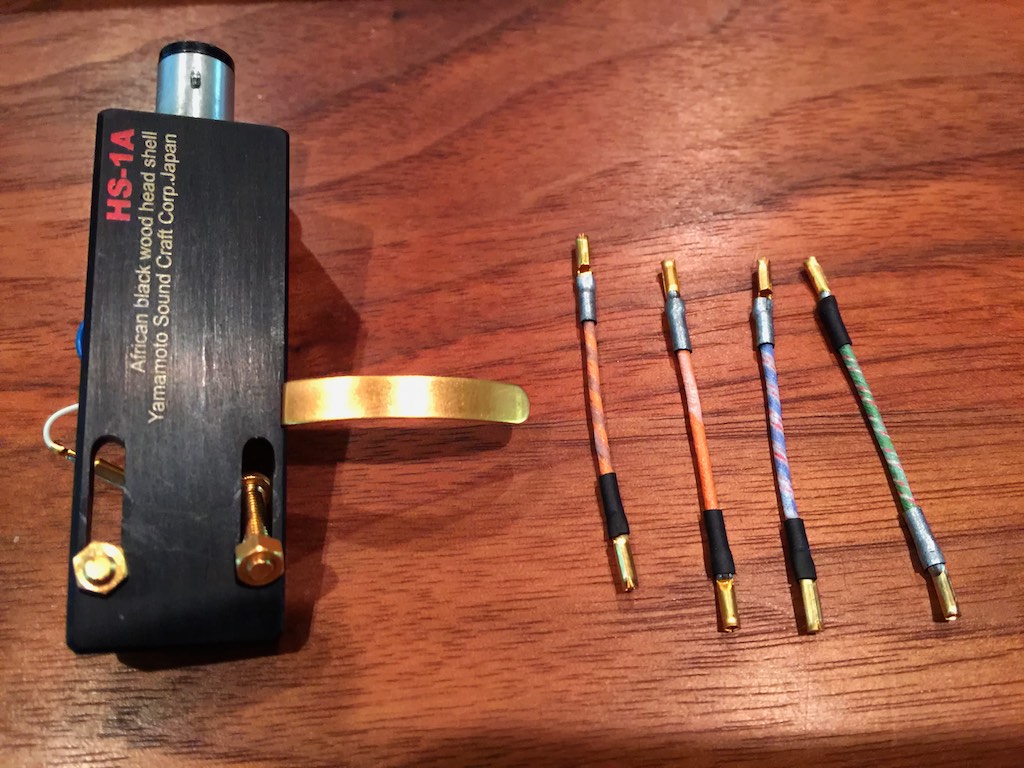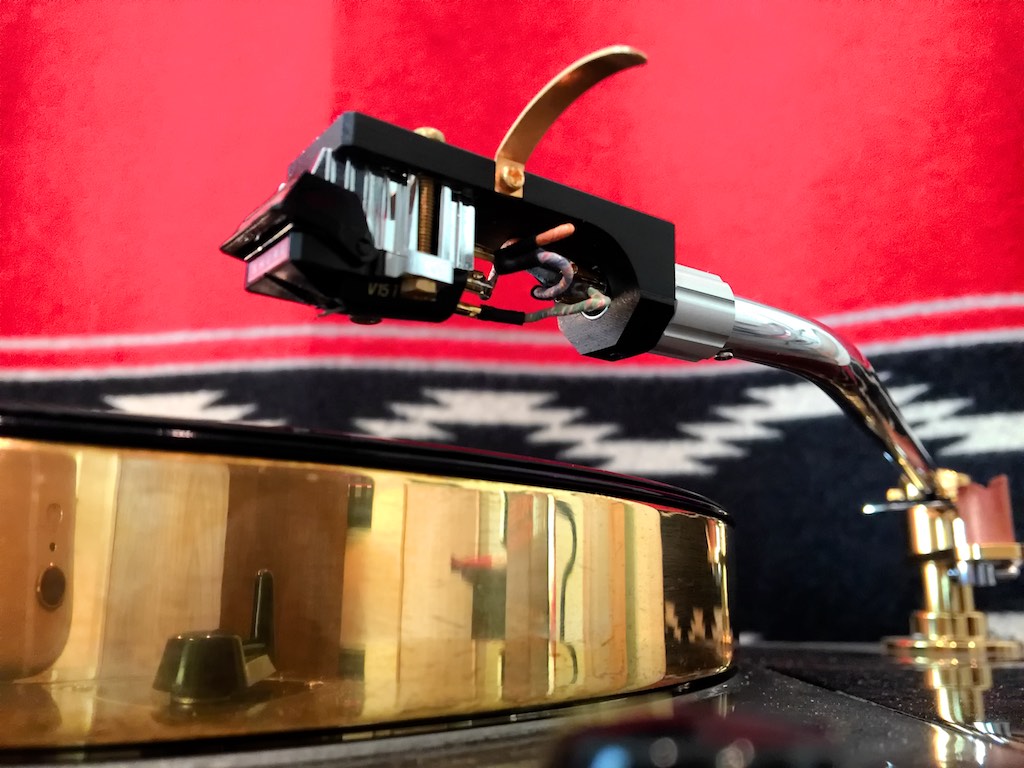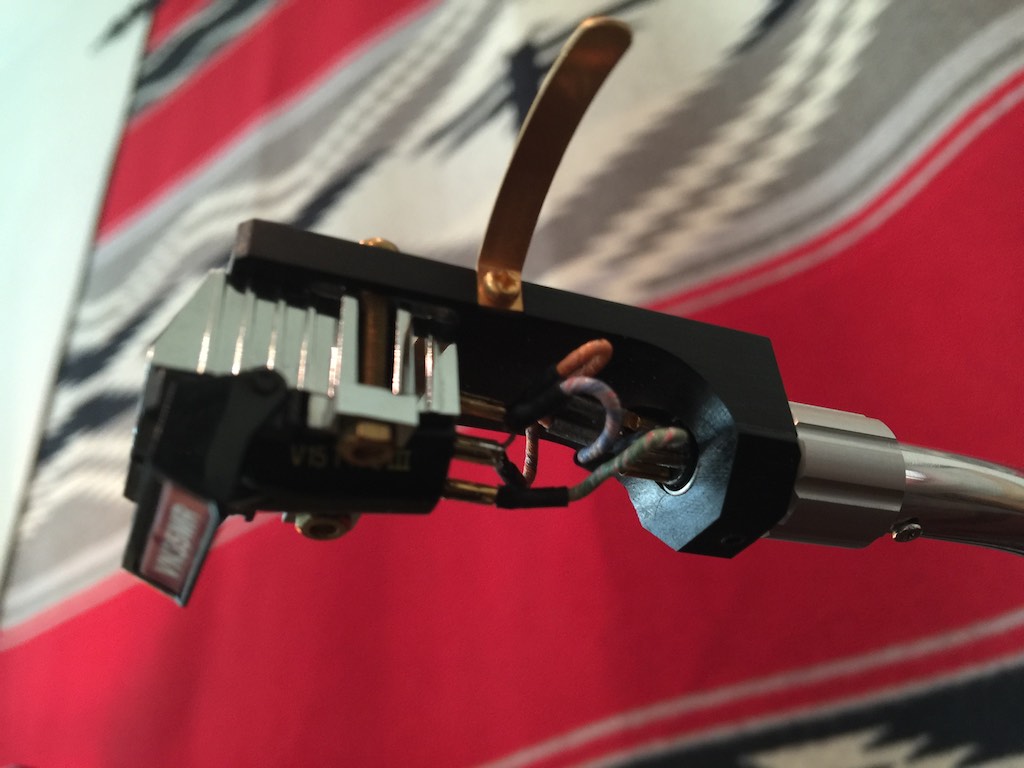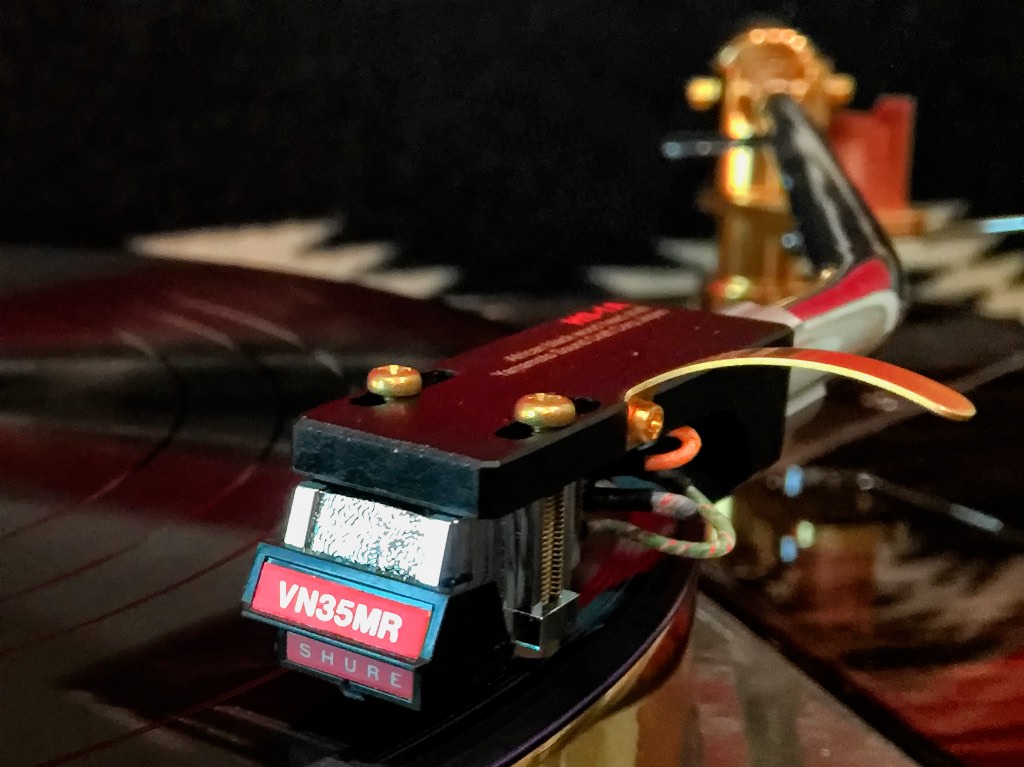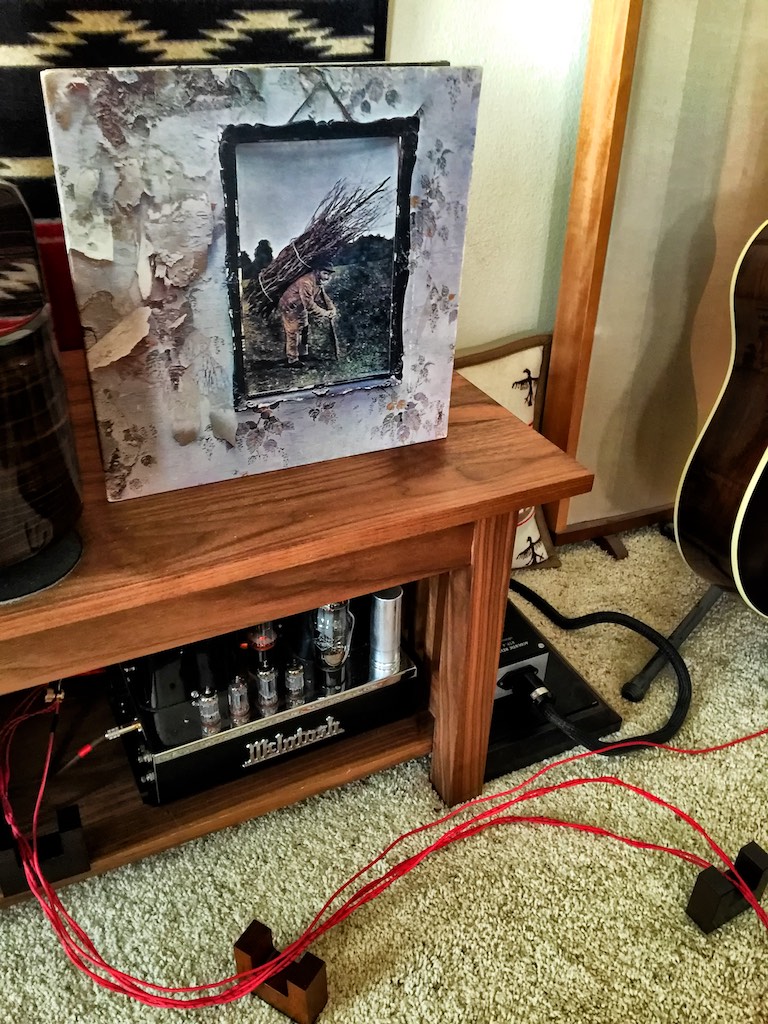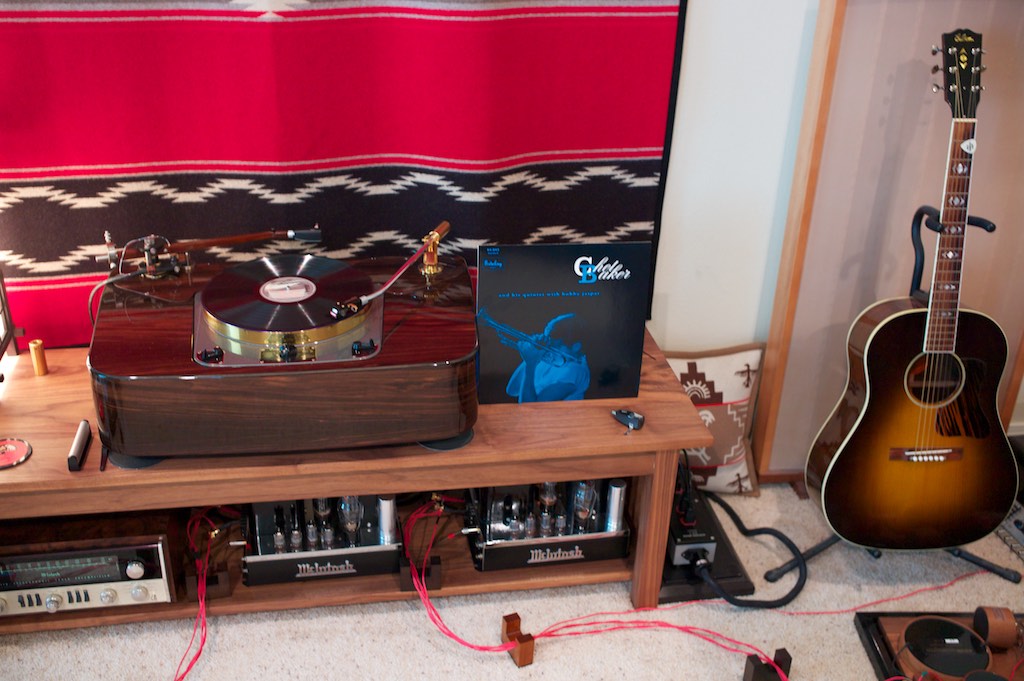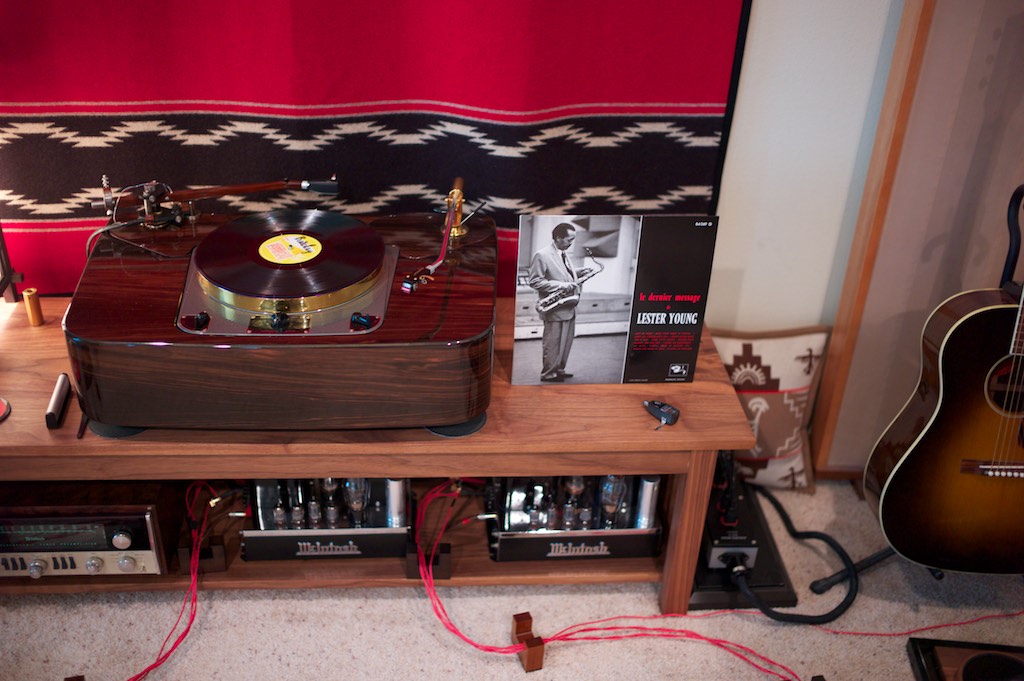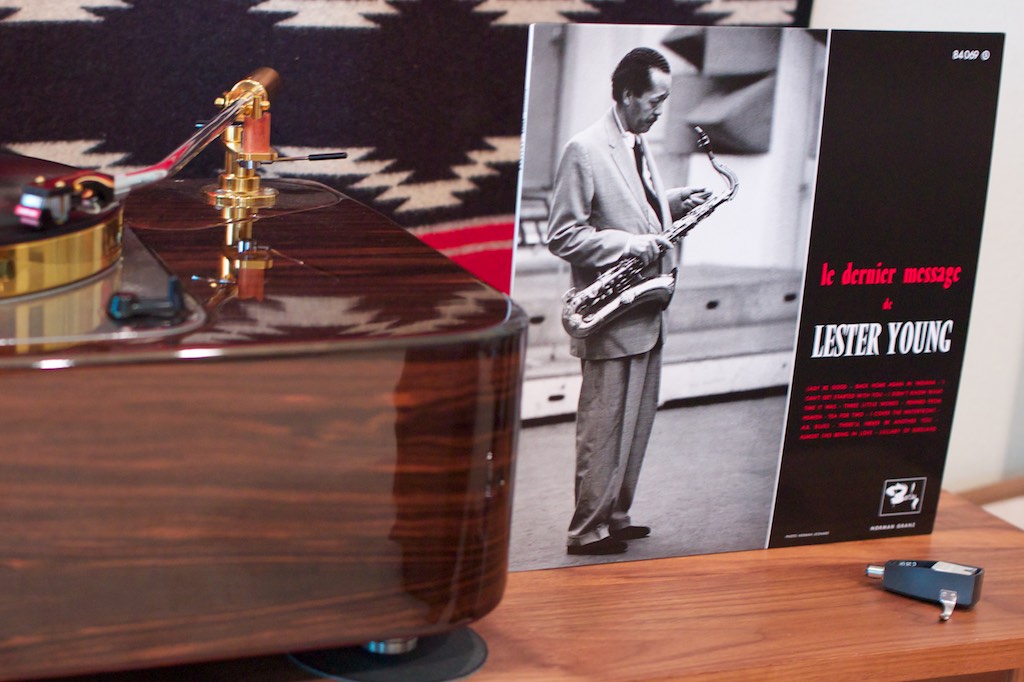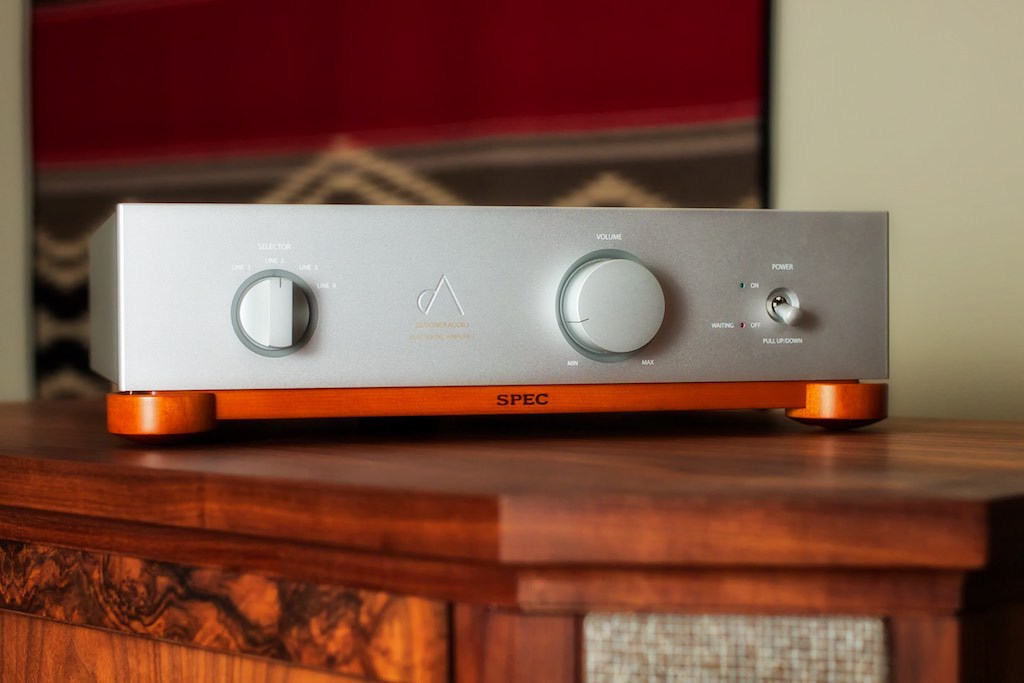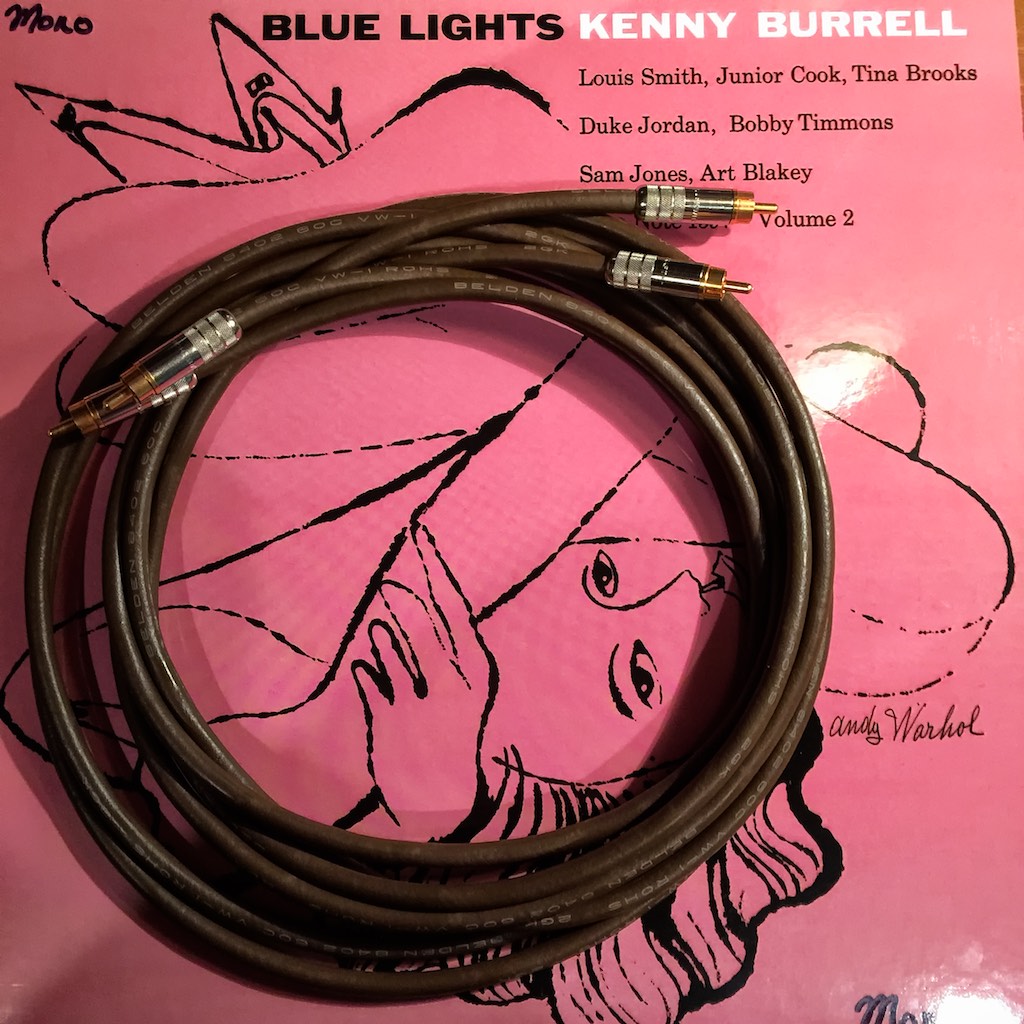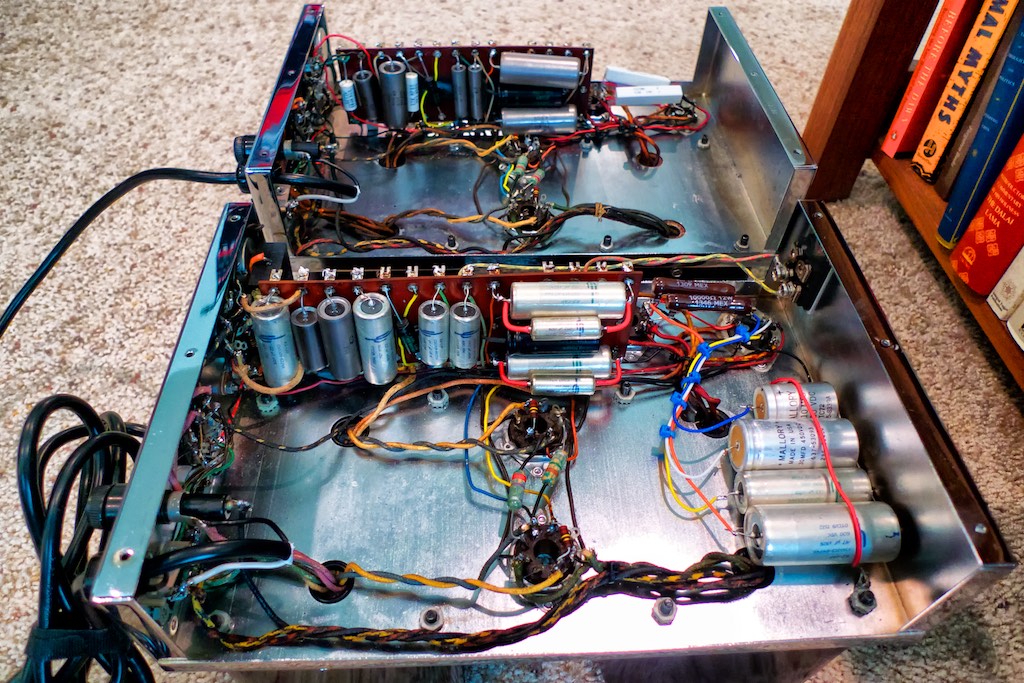It's been a hectic time, and I haven't been able to post as much as I'd like over the last few weeks, so I thought I'd tell you about a number of things at once to make up for lost time, like vintage Western Electric WE24GA wire, some delicious vintage phono cartridges, some music 'scores', and more!
First up is a secret that Yazaki-san shared with me, which is using vintage Western Electric WE24GA single conductor wire as headshell wires (below). In the photo below you can see the vintage WE24GA headshell wires that I swapped out for the stock wires on my Yamamoto headshell.
In the photo below you can see the vintage Western Electric headshell wires compared to the stock Yamamoto wires. The vintage Western Electric wires have a single conductor with a fabric wrap, and they are a lot larger than your usual headshell wires. They are also rather stiff, so they are a bit of a challenge to work with.

Bottom view of the Yamamoto headshell with stock wires. Note the difference in size of the vintage Western Electric WE24GA!
Headshell wires are pressed onto the pins of the connector, so all you do is grab a pair of tweezers and pull them off. The connector pins on the vintage WE24GA headshell wires that Yazaki-san sent me were quite a bit tighter than the ones on the stock headshell wires, so I used a safety pin to spread them a little to fit, then used tweezers to push them in place.
I had to do the same to mount the wires to the pins on the phono cartridge. They were a tight fit, and the vintage WE24GA wires are stiff so it's a bit tricky, so you have to be careful or you'll break off a connector and then have to solder it back on the wire, which is no fun given their small size (don't ask!).
I listened to a very nice vintage phono cartridge & stylus combination that Yazaki-san recommended I try (more about that in a moment), with both the stock Yamamoto headshell wires and the Western Electric WE24GA headshell wires.
The difference in sound & musicality between the stock & WE24GA headshell wires was at least as big in magnitude as the difference between different interconnects. The WE24GA headshell wires soundly trounced the stock headshell wires, bringing the same sorts of gains in richness, texture, tone color, emotional connection, etc., as do the Belden 8402 microphone cable interconnects or vintage Western Electric WE16GA wire as speaker cables.
Who would have thought that vintage WE24GA as headshell wires could have such a large positive effect? They do, and once you try them you'll never be able to go back (just when you thought you were safe!).
I have to grab a quick bite of dinner, then I'll be right back - I've got a lot more to tell you about!
***
Ok, I'm back. For dinner I had a nice chicken kabob with veggies grilled on the barbecue, and a couple of superb glasses of wine - Kiona 2012 Old Block from Red Mountain - courtesy of my buddy John Jaffe, who has superb taste in both wine and audio!
I'm still marveling that the vintage Western Electric WE24GA headshell wires could have such a large positive effect, but they do.
Now I want to tell you about the vintage phono cartridge Yazaki-san suggested I try, and which he is also very fond of, and has been using for many years. It's a really nice sounding phono cartridge, and the magic trick to make it come alive with Real Sound is the vintage WE24GA headshell wires, and as I found by accident, a non-typical vertical tracking angle.
The mystery vintage cartridge is the Shure V15 III with a VN35MR stylus (yes, the cartridge body & stylus were sold separately!). After looking for a while, I found one on eBay from a gentlemen is the UK, for the princely sum of £200 (about $300 USD). Ok, that's not exactly cheap, but it is a sweet listen, and well worth the investment!
***
I was feeling a little thirsty, so before continuing this post, I filled my wine glass with a delicious 2007 Grgich Hills Estate Cabernet Sauvignon from Napa Valley, courtesy of my buddy Leo, who is also a man of superb taste in both wine and audio!
Man, it rocks to have such cool friends! Thank you John and Leo!
***
Ok, so where was I? Oh yeah, the combination of a vintage Shure V15 III with a VN35MR stylus, and with vintage Western Electric WE24GA headshell wires, is heavenly!
I made a discovery about the Shure by accident. Wait, wait ... let me back up a little here. It's been a great weekend with long-distance audio pals David Rives, Kara Chaffee (deHavilland Electric Amplifier Company), and Harry Zweben (Two Bald Guys Audio alumni) all visiting, along with audio pals Pete Riggle (Pete Riggle Audio Engineering), Ron-san, John Jaffe, and the good doctor Leo, all converging on Jeff's Place for some hi-fi fun & games, as well as some excellent beverage consumption!
Pido brought along another rather rare vintage cartridge & stylus combination for us all to listen too - which will remain a secret until I can locate one to buy for my cartridge stash - that was freaky good. So after we were all wowed listening to Pete's rare phono cartridge & stylus combination, I made a discovery ... wait, wait, let me back up a little bit more.
A lot of times when audio nuts get together they listen to a bunch of prissy audiophile-style recordings and talk about the sound and analyze it. I thought, 'screw that' and instead I dragged out a bunch of vintage rock & roll albums, the Stones, Led Zeppelin, Simon & Garfunkel, Neil Young, and the like, and I cranked them up to live levels, and we blew the freakin' windows out!
You know what? No one complained about the music selections & loud volumes, and I noticed everyone was happy, laughing, talking, and having a blast! A number of pals even thanked me for taking things in that direction, and complemented me on the way my system was sounding (it's a picky bunch of audio cats, so that was sweet)!
So what's my point?
When I got my system dialed in, using Yazaki-san's Real Sound recommendations, I could blast out howitzer-like volumes and our ears never shut down, the music just came alive, and it was a lot of fun!
There's a lot of value to that, and not only can you play any music you want to and enjoy the heck out of it - like vintage rock & roll - more typical audiophile fare, or just the generally well recorded jazz that I normally like to listen to, sounds positively otherworldly!
Ok, back on topic: After listening to Pete's gorgeous sounding mystery vintage cartridge & stylus combo, I mounted up the vintage Shure V15 III & VN35MR stylus with the Yamamoto headshell & vintage Western Electric WE24GA headshell wires, then quickly adjusted the tracking force & azimuth, and completely forgot about adjusting the VTA.
Pido's vintage mystery cartridge needs its butt up pretty high to work right, and I forgot to drop the VTA back down in all the excitement of the evening. When I listened to the Shure earlier in the day, setup to manufacturer instructions, I thought it sounded pretty nice, but a little bright for my tastes compared to my Ortofon SPUs, or particularly compared to Pete's vintage mystery cartridge that was so rich & natural sounding.
The Shure sounded good, but not great. Then with my accidental VTA setting for Pete's mystery cartridge, the Shure leaped to life and sounded mesmerizing! Rich, colorful, astonishingly musical, with great timbral texture, and just fun to listen to music with.
So the take home message is, if you can find one of these vintage phono cartridge jewels, don't be afraid to set the VTA higher than you normally would, use Western Electric WE24GA headshell wires, and you might find it to be a very rewarding experience.
Ok, I've teased you enough with the glories of vintage Western Electric WE24GA as headshell wires, vintage phono cartridges & styli, but now it's time to take a break, and then I'll be back with more!
***
Ok, I'm back. Now I've got some music recommendations for you.
In the post "Personal Thoughts About 'Real Sound' from Mr. Yazaki-san of SPEC" I mentioned how much fun Chad, Pete, and I had playing a box of pristine 60 year-old old Decca 45s (above) that Chad found buried in the basement of his cabin on lake Chelan, that had belonged to his long-departed Auntie (it used to be Auntie's cabin, then passed down through the family line, and now residing in Chad and his sister's hands - what a treasure!).
I can imagine how much fun Auntie must have had sitting in her cabin in its Walden-like setting, looking out over the lake from her porch at sunset, with the mountains in the background, a bourbon in hand, enjoying the music. Now that's fine living!
When I saw that Sam Records pressed a limited edition run of Chet Baker And His Orchestra on a 45 rpm 7-Inch EP, I remembered the fun we had listening to Chad's vintage 45s, how good they sounded, so I immediately bought a copy (there were only 200 pressed, so if you want one you better act fast).
The Acoustic Sounds website says that "This was Chet's last visit to the Pathé-Magellan studio, and he was to be reunited with a septet: he'd loved the Pierre Michelot arrangements he'd recorded five months earlier ... These four pieces, all grand finales among the works recorded in France for the Barclay label, proved to be irrefutable arguments showing that jazz now had a new voice to be reckoned with, a voice was uniquely original."
As far as I know, these four cuts by Chet Baker of Mythe, Not Too Slow, Vline, and In A Little Provincial Town are not available on any other currently available Chet Baker record, so you may want to act fast to get it for your collection before they're gone. These recordings are one more reason I admire Chet Baker and French contributions to culture - four great music selections, great sound, and it's only $15 USD. Can't beat that!
Here's another limited edition Chet Baker treasure from Sam Records (above), the Chet Baker And His Quintet With Bobby Jaspar album, recorded in 1955 in Paris. It's more great music that you'll want to get for your collection if you're a Chet Baker fan like I am. It's also the follow-up recording session to the great recordings on the 7-inch 45 mentioned above.
The Acoustic Sounds website says about the recording, "Chet entered the Studio Pathé-Magellan on October 25th with only Jimmy Bond and his contrabass left from his original accompanying trio. In the ensuing octet session Chet’s melodic gifts were magnified by (remarkable) scores penned by Pierre Michelot – Chet, Dinah – and Christian Chevalier (Vline). The three pieces were mini-concertos, and sounded magnificent. On November 28, Chet went back into the same studio, this time with Raymond Fol on piano, Benoît Quersin on bass and Jean-Louis Viale on drums. They recorded two improvisations: the first was based on a 1932 standard from Howard Dietz and Arthur Schwartz, "Alone Together", while the second began with "Exitus", a composition written by one of Baker’s friends, Phil Urso. The performances are among the most beautiful that Chet produced during this period, along with "Chekeeta" — or Chik-Etah — and "How about You?""
I'm sorry to tell you this, but this limited edition pressing of Chet Baker And His Quintet With Bobby Jaspar from Sam Records has already sold out at Acoustic Sounds in the few days that have passed since I bought mine, but it's really good, so I recommend you try to find one in stock somewhere before they're completely extinct, and grab one, it's a treasure!
Here's another Sam Records limited edition French treasure: Lester Young's Le Dernier Message De Lester Young, and for the moment it is still in stock at Acoustic Sounds.

Listening to 'Le Dernier Message De Lester Young' with the vintage Shure V15 III + VN35MR stylus with a vintage Western Electric WE24GA wired headshell - sublime!
From the Acoustic Sounds website: "In January 1959, Lester Young was in Paris for a series of concerts at the famous Blue Note Club. He plays with Rene Urtreger on piano, Kenny Clarke on drums, Jimmy Gourley on guitar and Jamil Nasser on bass. On March 4, 1959, Eddie Barclay decides to record Lester at Studio Barclay, which will be Lester's last album. This legendary recording session is poignant and moving in line with Coleman Hawkins' Sirius and the last recording of Billie Holiday. Lester Young is reduced but the grace and genius are still there! Some days later, on March 15, 1959, Lester succumbs at the Alvin hotel, a few hours after arriving in New York. A heart attack had just defeated the tenor sax master fellow musicians nicknamed "Prez" — The President."
I just listened to Le Dernier Message De Lester Young with the vintage Shure V15 III cartridge & VN35MR stylus combo with the vintage Western Electric WE24GA wired Yamamoto headshell, and it was sublime! This is another limited edition pressing, so if you want one, don't dally or they'll be gone.
I almost forgot to mention that Le Dernier Message De Lester Young, Chet Baker And His Quintet With Bobby Jaspar, and Chet Baker And His Orchestra are all in glorious mono, but sound mighty fine played back with a stereo cartridge too.
Another limited edition mono treasure is the Sam Records reissue of Barney Wilen's Jazz Sur Seine.
From the Acoustic Sounds website: "Tenor saxophonist Barney Wilen was not quite 21 years old at the time of this meeting with Milt Jackson, Percy Heath, and Kenny Clarke, three veterans of the Modern Jazz Quartet. But the young man is surprisingly mature and confident throughout the session, interpreting several of Django Reinhardt's compositions, along with a few by his French contemporaries and a pair of his own works. What's surprising about this session is the rare opportunity to hear Jackson exclusively as a pianist, as his playing is a bit more reserved than on vibes. The leader digs into his rhythm section's element with his original "B.B.B. (Bag's Barney Blues)", giving them a full chorus before making a convincing statement himself. The quartet's fluid arrangement of Thelonious Monk's "Epistrophy" swings. Percussionist Gana M'Bow is added for both "Swing 39" and "Minor Swing" to add an exotic touch. Barney Wilen easily holds his own on his first major meeting on a record date with major American jazz stars. Miles Davis recruited Wilen for his European tour dates at this time (1957), a measure of Davis's estimation of the young Barney. Recording: February 1958 in Paris"
As of this moment this limited edition release is still in stock at Acoustic Sounds, so get it while you can!
Ok, that's it for now. I'll be back in a bit with more!
***
Ok, I'm back, and this will be the last installment for this particular post.
I am in the process of writing an article entitled Adventures in Real Sound with Mr. Shirokazu Yazaki for Positive Feedback, that will also appear here at Jeff's Place in due time. I'm hoping to have it finished in the next few weeks. It's my first attempt at trying to write a full-length article since getting sick. I'm far from out of the woods on the health front, but I'm feeling better due to some astute docs, and if all goes well with writing this article, then I am going to try to pick back up where I left off with my reviews, assuming the folks I had to put 'on hold' in my review queue still want to do that, and if not, then I'll be writing about something else instead.
As you know if you've been reading along, Yazaki-san has amazed me with his ability to produce extremely musical results in almost any medium, whether it be vacuum tubes, solid-state, capacitors, resistors, or wire!
I think Yazaki-san's Real Sound interpretation of what audio should perform like is breaking new ground musically, and I'm really excited about it. In Adventures in Real Sound with Mr. Shirokazu Yazaki I am going to summarize my experiences with Real Sound, discuss what I think is its essence, and how it effects me as a listener.
I'll talk about my experiences with the Belden 8402 microphone cable interconnects ...

Vintage Western Electric WE16GA wire. It's getting hard to find but it is well worth searching it out.
... and my experiences with Western Electric WE16GA wire as speaker cables, crossover wiring, and internal wiring in my Westminster loudspeakers ...
... about the Capacitor Adventure with my vintage McIntosh MC30 monaural amplifiers that Yazaki-san & Ron-san and I embarked upon ...
... then the Resistor Adventure with the Macs that followed the Capacitor Adventure ...
... and the British Fineness of Tone adventure with Mullard & Haltron vacuum tubes ...
... and I'll wrap up with the latest scoop on vintage phono cartridges and Western Electric WE24GA headshell wire.
I also want to tell you that you can meet Yazaki-san in person at the Rocky Mountain Audio Fest in Denver, Colorado, October 2-4. Jonathan Halpern (Tone Imports) will be setting up a demo room for Yazaki-san, and if you've followed my postings about Jonathan's setup of rooms (Winning Combinations), you know how often Jonathan wows everyone with 'best sound of the show', so you know it's going to be good. Be there or be square!
Well, that's all for now, and I hope you have enjoyed this post - thanks for stopping by!




